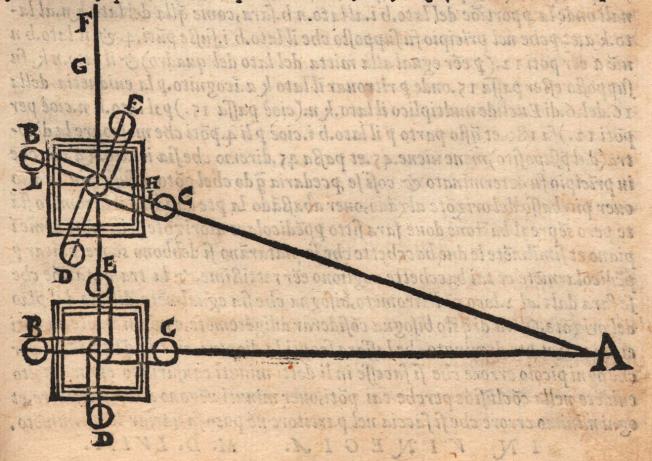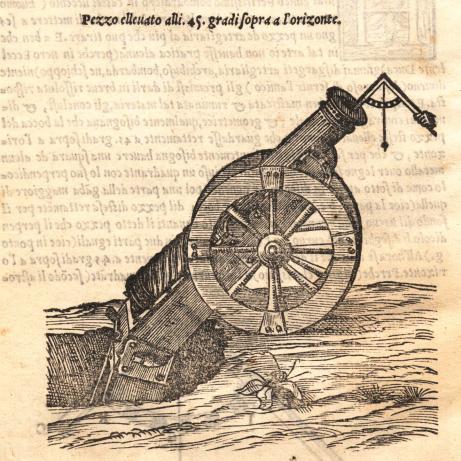In 1537, Nicolò Tartaglia (1500–1557), a mathematician from Brescia, published Nova scientia. It was this work that led to the foundation of the modern science of ballistics. Tartaglia’s intention was to create a purely mathematical science based on axioms, which was fundamental to the entire subject of mechanics, starting with a limited number of principles and arriving at a series of propositions through a rigid procedure of deduction. Nevertheless, as Tartaglia himself states, his motive was fundamentally practical and connected to the activities of the sixteenth-century bombardier. A new edition of Nicolò Tartaglia’s Nova scientia, based on the 1558 print run of the second enlarged edition (1550), shows how the emergence of theoretical ballistics was a consequence of the technological innovations that took place in the frame of the practice of iron casting at the turn from the fifteenth to the sixteenth century.
The reconstruction of the process of emergence of modern ballistics on the base of Nicolò Tartaglia’s work sheds light on the relation between practical and theoretical knowledge in the frame of early modern preclassical mechanics. In particular, it shows how practical knowledge determined the agenda of theoretical research and how theoretical formulations then led to a coherent understanding of previously accumulated experience.

Fig. 2: Diagram to show variations in the range of cannon shots according to the elevation of artillery above the horizon. From Niccolò Tartaglia, Nova scientia, Venetia, 1558, Second Book, 11v.
According to this approach, which carefully considers the technological context surrounding Nova scientia and its author, the new edition provides an English translation of the entire work (by Matteo Valleriani, Lindy Divarci and Anna Siebold). The previous translation, accomplished by Stillman Drake and I. E. Drabkin (1969), does not include the whole third book, which, more than the other two, shows the connections between Tartaglia's science and the practical knowledge of his time. Moreover, this new edition is not based on the first edition of Tartaglia's work from 1537, but on the 1558 print run of the second edition (1550). In the second edition, Tartaglia made relevant additions to the third book and to some propositions of the other two. The 1558 print run, moreover, shows a text that has been rendered more comprehensible due to typographical improvements made shortly after Tartaglia's death. Content relevant changes between the editions are systematically annotated.
The first theory of ballistics achieved a relevant result. According to this theory, the maximal range of a cannon is reached when the same cannon is elevated 45 degrees above the horizon. In the text, Tartaglia bases his main results on a series of tests executed by means of cannons. Such tests in turn resulted from a dispute among bombardiers, which Tartaglia, who presents himself as a sort of referee, solved theoretically. Tartaglia indeed applied a theoretical grid to the physical problem in question, specifically, Aristotelian dynamics, which was the only theoretical grid at disposal in his time. Once he had found a way to simplify the problem by eliminating the issue of friction, Tartaglia applied by definition the Aristotelian concepts of natural and violent motion.

Fig. 3: A graphic representation of a surveying instrument conceived by Niccolò Tartaglia with a dioptra installed on top. The image shows the two phases of the measurement procedure used to calculate the distance between the instrument below (observer) and point A. The design and construction technique of this instrument, as well as instructions on how to use it, were added by Tartaglia to the Third Book in the second 1550 edition. From Niccolò Tartaglia, Nova scientia, Venetia, 1558, Third Book, 32r.
Tartaglia proceeded by cutting the trajectory of the cannonballs into different portions and then identifying them with the two different sorts of motion his conceptual apparatus was able to provide. The theory of ballistics that emerged from this operation was basically an analysis of the portion of the trajectory that was associated with violent motion. On the basis of this procedure, Tartaglia was able to draw quantitative consequences not only concerning the maximal range, but also concerning the variation in the destructive power of cannon shots in dependence on the distance between target and cannon, and on the elevation of the artillery.
The tests executed by means of cannons, around which Tartaglia narrates in his work, merely symbolize the background against which the new science of ballistics emerged. Clearly, and as it has already been stated by several scholars, the background knowledge involved in the process of emergence of the theoretical ballistics was represented by the experiences made by artillerists and bombardiers. Weapons powered by gunpowder, however, had been available for more than a century when Tartaglia wrote his treatise. Indeed, the diffusion of firearms is not the only condition that is able to justify Tartaglia's theoretical formulations historically. The aim to analyze the range and destructive power of artillery by investigating violent motion could only be achieved once the firearms started to produce material effects along the line of the part of trajectory that Tartaglia identifies with violent motion. Until the end of the fifteenth century, however, this was almost never the case. Up until that point, the heavy artillery usually fired massive cannonballs as high as possible, which then accomplished the desired destruction with their fall, that is, along the part of trajectory that Tartaglia identifies with the Aristotelian concept of natural motion.

Fig. 4: Image of a cannon elevated at 45 degrees above the horizon using the artillerist’s quadrant. After the emergence of modern ballistics in the sixteenth century, the quadrant, which had been in use for over a hundred years, was no longer used to record the elevation of well-targeted shots, but to position the cannon in advance to hit previously determined targets. From Niccolò Tartaglia, Nova scientia, Venetia, 1558, Dedicatory Letter.
At the end of the fifteenth century, cast-iron cannon balls started to be produced. This meant that the size of the artillery could be reduced, but with an enormous increase in their destructive power. There was an evident increase in the velocity of the shots as well. Indeed, it was the firearms constructed after the adoption of this metallurgic innovation that explain the emergence of modern ballistics. The link between the experience accumulated with artillery of this kind and the theoretical approach to such experiences is finally identified with the use of the quadrant for bombardiers, which had also been in use long before Tartaglia published his work. This instrument, first used to record data for single shots, is the vehicle of the process of emergence of a new theory, which in turn was used to describe and explain previously accumulated experience. From the status of practical instrument, it became the expression of a theoretical approach.
The volume will appear in the series Sources of the Max Planck Research Library for the History and Development of Knowledge. This series presents historical documents in a new format that combines the advantages of traditional printed books with those of the digital medium. In this volume the source text is reproduced in facsimile, together with an introduction, the transcription and the annotated English translation. The volume will be available both as print-on-demand book and as open-access publications on the Internet. The material will be freely accessible online at www.edition-open-access.de.
